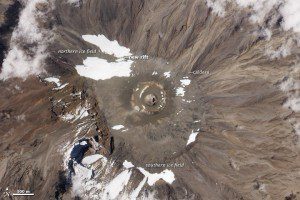
The Advanced Land Imager on NASA's Earth Observing-1 satellite acquired this image of Mount Kilimanjaro on Oct. 26, 2012.
The views from the top of Mount Kilimanjaro”a 5,895-meter (19,341-foot) dormant stratovolcano in Tanzania”are as surreal as they are spectacular. After ascending through multiple ecosystems”including cropland, lush rainforest, alpine desert, and a virtual dead zone near the summit”climbers can find themselves peering down on a thick blanket of clouds below that seems to stretch endlessly in the distance.

During a September 2012 expedition, NASA researchers discovered that Mount Kilimanjaro's northern ice field had separated into two parts.
But in the immediate foreground, ice dominates the view. Looking north, a shelf-like block of ice with a sharp vertical cliff sits on an otherwise featureless, sand-covered plateau. In the other direction, a second ice field spills off the edge of the plateau, down the mountain's southern face.
Between 1912 and 2011, the mass of ice on the summit decreased by more than 85 percent. Researchers say it's no longer a question of whether the ice will disappear but when. Estimates vary, but several scientists predict it will be gone by 2060.
Rising air temperatures due to global warming could be contributing to the ice loss, but several other factors are just as important, if not more so. An increasingly dry regional atmosphere, for example, is starving the mountain of the fresh snow needed to sustain the ice fields. Drier air also is reducing cloud cover and allowing more solar energy to warm the ice surfaces.
Kimberly Casey, a glaciologist based at NASA's Goddard Space Flight Center, was taking part in a September 2012 research expedition to Kilimanjaro to study the ice at the summit and noticed yet another ominous sign”the northern ice field, which had been developing a hole since the 1970s, has separated.
This was the first year that the northern ice field completely divided into two, said Casey. We were able to walk on land”or we could have even ridden a bicycle”directly through the rift.
Images courtesy of NASA.


